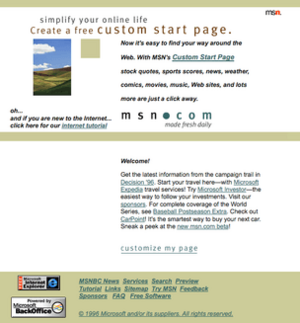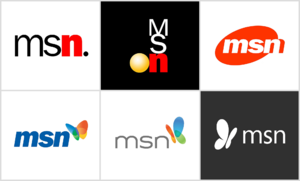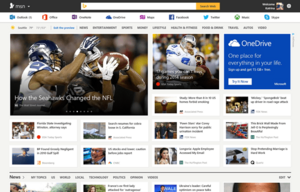MSN facts for kids
 |
|
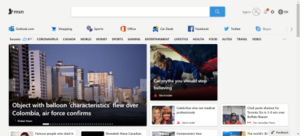
Current home page in June 2025
|
|
|
Type of site
|
Web portal |
|---|---|
| Area served | Worldwide |
| Owner | Microsoft |
| Commercial | Mixed |
| Registration | Optional |
| Launched | August 24, 1995 |
| Current status | Active |
| Written in | ASP.NET |
MSN is like a big website (called a web portal) and a group of online tools and apps from Microsoft. Its main page gives you news, weather, sports scores, and money updates. It gets this information from many different partners. MSN is from the United States, but it has versions for many countries worldwide. You can also get its special app on iOS and Android phones.
MSN first started on August 24, 1995, when Windows 95 came out. Back then, it was a service you paid for, called The Microsoft Network. Later, it became an Internet service provider called MSN Dial-Up Internet Access. Around the same time, Microsoft launched a new web portal called Microsoft Internet Start. This was the default home page for its web browser, Internet Explorer.
In 1998, Microsoft changed the name of "Microsoft Internet Start" to "MSN" and moved it to the website address msn.com. It has been there ever since. Over the years, Microsoft used the "MSN" name for many different products and services. These included MSN Hotmail, MSN Messenger (which many people just called "MSN"), and its web search engine (which is now Bing). In 2014, Microsoft updated the MSN website and its apps. In 2021, parts of the website were renamed Microsoft Start, but in 2024, Microsoft decided to keep "MSN" as the main name for the website.
Contents
How MSN Started and Grew
The First Microsoft Internet Start
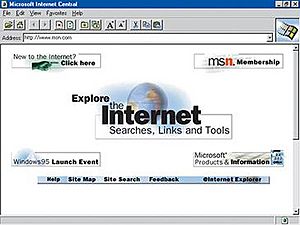
From 1995 to 1998, the MSN.com website was mostly used to promote The Microsoft Network. This was Microsoft's online service and Internet provider. During that time, MSN.com also had a "Custom Start Page" and a guide to using the Internet. However, Microsoft's main public web portal back then was "Microsoft Internet Start," found at home.microsoft.com.
Internet Start was the default home page for Internet Explorer. It offered simple information like news, weather, sports, stock prices, and entertainment reports. It also had links to other websites, articles by Microsoft staff, and updates for Windows. Microsoft's first news website, MSNBC.com, which started in 1996, was also closely linked to the Internet Start portal.
The Rise of MSN.com
In 1998, the "MSN.com" website address was combined with "Microsoft Internet Start." It was relaunched as a web portal and a brand for many websites made by Microsoft. This new MSN website competed directly with sites like Yahoo! and Excite. Because the new MSN offered its content for free, the Internet service provider part was renamed "MSN Internet Access."
The new MSN.com included many different websites. Some had original content, while others were carried over from earlier "web shows." New features were quickly added. MSN.com became the new default start page for Internet Explorer, as all of the old "Microsoft Internet Start" website was moved into MSN.com.
Some of the first websites Microsoft launched during this time stayed active for many years. Microsoft Investor, which gave business news and investments information, became MSN Money. CarPoint, a service for comparing and buying cars, became MSN Autos. The Internet Gaming Zone, a website with online casual games, became MSN Games. Other websites that Microsoft later sold include the travel site Expedia and the online magazine Slate.
In the late 1990s, Microsoft worked with many other companies and its own departments to add more services to MSN. Examples include MSN adCenter for ads, MSN Shopping for shopping, and the Encarta encyclopedia.
MSN.com stayed a popular place to visit, launching many new services and content sites. MSN's Hotmail email and Messenger chat services were promoted from the MSN.com portal. This made MSN.com a central spot for all of MSN's content. MSN Search (which later became Bing), a special search engine, started in 1999. The single sign-in service for Microsoft's online tools, Microsoft Passport (later Microsoft account), also launched across all MSN services in 1999.
The MSN.com portal and its related services stayed mostly the same in the early 2000s. This time also saw the introduction of the MSN butterfly logo on February 14, 2000. This logo then became the symbol for all MSN services.
From 2001 to 2004, the sports section of MSN was ESPN.com. From 2004 to 2014, it was FoxSports.com. MSN also had a special partnership with MSNBC.com for news from 1996 until 2012. In 2012, Microsoft sold its share in msnbc.com, and the website was renamed NBCNews.com. At that time, MSN started its own news service called "MSN News."
By May 2005, MSN.com was the second most visited portal website in the United States. It had 23.2 percent of visitors, while Yahoo! had the most.
MSN showed a sneak peek of a new home page and logo on November 3, 2009. It was expected to be available to over 100 million U.S. customers by early 2010. MSN launched the new logo and a redesigned website on December 25, 2009.
In 2012, MSN announced a new version of its home page for Windows 8. This new version was "clean, simple, and built for touch." Microsoft said it would feel more like an app because of how fast Internet Explorer 10 was. New features included "Flip Ahead," which let users swipe from one article to the next. MSN for Windows 8 also made new deals with the AP and Reuters for content.
Changing Service Names
Many of MSN's services were reorganized in 2005 and 2006 under a new brand name called Windows Live. This was part of Microsoft's plan to make its online services better using the Windows brand. The company also updated its online software and services because of more competition from rivals like Yahoo! and Google. The new name was introduced one service at a time. The Windows Live services used Web 2.0 technology. This allowed them to offer features through a web browser that usually needed special software programs.
Some MSN services that changed names included MSN Hotmail, which became Windows Live Hotmail (now Outlook.com). MSN Messenger became Windows Live Messenger (later part of Skype). MSN Search became Live Search (now Bing). MSN Virtual Earth became Live Search Maps (now Bing Maps). Other services, like MSN Direct, stayed part of the MSN family without changing to Windows Live.
After Windows Live launched, the MSN brand focused more on being an online content provider. It offered news, entertainment, and general interest topics through its web portal, MSN.com. Windows Live, on the other hand, provided most of Microsoft's online software and services. In 2012, Microsoft started to stop using the Windows Live brand. Each service was then called by its own name without "Windows" in front.
Website Makeover
Microsoft launched a completely new and redesigned MSN website on September 30, 2014. This new MSN portal used Microsoft's modern design style. The website no longer created its own content. Instead, it used editors to gather content from trusted partner organizations. Much of the old content on MSN was removed as the website became simpler. It now had a new home page and categories, some of which had matching apps:
- News: The latest news and articles from many hand-picked sources (also in the MSN app).
- Weather: Current weather, forecasts, maps, and traffic (also in the MSN Weather app).
- Entertainment: TV, movies, music, and celebrity news, plus showtimes and tickets.
- Play: The MSN Games website offers online casual games.
- Sports: Up-to-the-minute scores, standings, and headlines from leagues worldwide.
- Money: Stock market prices, personal finance, real estate, and a currency converter (also in the MSN Money app).
- Lifestyle: News and articles about style, home, family, and relationships.
- Health & Fitness: Tools and information about weight, exercise, and medicine.
- Food & Drink: Recipes, cooking tips, and shopping lists.
- Travel: Destinations, trip ideas, hotel and flight search.
- Autos: Research and buying advice for cars, and auto news.
- Video: Popular videos, comedy, and videos from other MSN categories.
In 2014, the top of the home page gave access to Microsoft services like Bing, Outlook.com, Skype, and OneDrive. It also linked to popular social media services like Facebook and Twitter. If you signed into MSN with a Microsoft account, you could see personalized content. This content would also sync across your devices and the matching apps. The website redesign meant that MSN no longer needed a separate mobile website. The new design helped increase visitors, adding 10 million more daily visitors after two months.
In 2021, Microsoft started to move away from MSN towards Microsoft Start. This included an updated design and news pages moving to Start. However, in November 2024, Microsoft changed its mind. The Microsoft Start page now sends users back to MSN. Microsoft also brought back the MSN app in November 2024.
MSN Apps
 |
|||||||
| Other names |
|
||||||
|---|---|---|---|---|---|---|---|
| Developer(s) | Microsoft | ||||||
| Initial release | 26 October 2012 | ||||||
| Stable release(s) [±] | |||||||
|
|||||||
| Operating system | Windows, iOS, Android | ||||||
| Type | News aggregator | ||||||
 |
|||||
| Other names | Bing Weather (2012–2014) | ||||
|---|---|---|---|---|---|
| Developer(s) | Microsoft | ||||
| Initial release | 26 October 2012 | ||||
| Stable release(s) [±] | |||||
|
|||||
| Operating system |
Discontinued
|
||||
 |
|
| Developer(s) | Microsoft |
|---|---|
| Initial release | 7 February 2012 |
| Stable release |
4.53.63386.0 / 6 December 2024
|
| Operating system | Windows, Android |
The MSN apps give users information from sources that publish to MSN. Microsoft launched these apps with the 2014 redesign of the MSN website. They were rebranded versions of many Bing apps that first came with Windows 8 and Windows Phone in 2012. News, Weather, Sports, Money, and Travel apps first shipped with Windows 8. Health & Fitness and Food & Drink first appeared in Windows 8.1. In December 2014, the apps became available on other major mobile device platforms like iOS, Android, and Fire OS. Over time, the apps became available on fewer platforms.
The apps let users choose which sources provide information. Each app had its own color code. Originally, each app worked smoothly with the MSN website and synced your choices across devices.
There are currently three main MSN apps: the MSN app, MSN Weather, and MSN Money. In July 2015, Microsoft announced that the Food & Drink, Health & Fitness, and Travel apps would no longer be available. They were also not included with Windows 10. Those apps, along with Sports, are no longer offered.
The Main MSN App
The MSN app (also called Microsoft News on Windows, and previously Microsoft Start on iOS and Android) is a news aggregator. It shows top news headlines and articles chosen by editors and computer systems. It has news sections for top stories, U.S. news, world news, money, technology, entertainment, and sports. The app lets users pick their favorite topics and news sources. You can also get breaking news alerts and change font sizes to make articles easier to read.
This app first launched with Windows 8 on October 26, 2012. It was first called "Bing News," then "MSN News" in 2014, and "Microsoft News" in 2018. In 2021, it was relaunched as "Microsoft Start" on iOS and Android. In November 2024, Microsoft decided to bring back the "MSN" name for the app. This change was made to simplify the brand while keeping all the same features.
The app used to include an RSS feed, but that feature was removed. Now, Microsoft only lets users subscribe to specific news sources.
MSN Weather App
The MSN Weather app (originally "Bing Weather") shows weather for your current location or any other place in the world. You can save your favorite places, and these will sync across your devices. You can also pin Weather tiles to your Start menu to see local weather conditions quickly. It offers satellite maps and information about ski resorts. The app gets its weather information from many sources worldwide. The Weather app uses weather conditions as its background. It is not available for iOS.
MSN Money App
The MSN Money app (originally a website called "MoneyCentral," then "MSN Money") lets users create lists of companies to watch. You can follow certain companies and get stock updates. It shows the latest news about international markets and real-time trading figures (with a 30-minute delay). You can also track your own finances, calculate mortgages, and convert currency.
Apps That Are No Longer Available
The MSN Food & Drink app (originally "Bing Food & Drink") was a recipe app. It offered news about food and drinks, a personal shopping list that synced across devices, and a wine encyclopedia. Users could control the app hands-free and add their own recipes.
The MSN Health & Fitness app (originally "Bing Health & Fitness") let users track their calorie intake and look up nutrition information. It had a built-in GPS tracker and showed step-by-step workouts with images and videos. You could also check symptoms for different health conditions.
The MSN Travel app (originally "Bing Travel") was a travel search engine. It let users book hotels and flights. It also gathered travel news and offered details about thousands of travel destinations. This app was discontinued in September 2015.
The MSN Sports app (originally "Bing Sports") showed various sports scores and standings from leagues worldwide. It also gathered sports news and articles. Users could view photo galleries and track their favorite teams. This app was discontinued on July 20, 2021.
The MSN Esports Hub was an AI-powered web app launched in 2020 for the growing esports industry. Users could watch streams from YouTube or Twitch. Microsoft's AI, called "Watch For," could alert viewers to important moments in livestreams. Users could also check a calendar for upcoming esport events. This service was replaced by Start.gg.
Older Mobile Apps
Microsoft first offered content from its MSN website on mobile devices in the early 2000s. This was through a service called Pocket MSN, later renamed MSN Mobile. The original MSN Mobile software came preloaded on many cell phones and PDAs. It usually gave access to older MSN services like blogs (MSN Spaces), email (Hotmail), and instant messaging (MSN Messenger). Some phone companies charged extra to use it.
As many MSN services moved to Bing and Windows Live in the late 2000s, the Microsoft Mobile Services division took over making mobile apps for those services.
Meanwhile, Microsoft's MSN apps focused more on content, just like the website. Earlier MSN apps for Windows Mobile and early Windows Phone versions, as well as apps for Android and iOS devices in the early 2010s, mainly showed news articles from MSN.com.
After Microsoft bought Nokia's mobile phone division, Microsoft also started including MSN services with its Nokia-branded feature phones. The Nokia 215 was the only feature phone to have the MSN Weather app built-in.
MSN Around the World
Microsoft's main office is in the United States, so the main MSN website is based there. However, MSN has offered different versions of its website for many countries around the world since it started in 1995. You can find a list of international MSN partners on a web page called MSN Worldwide.
After the MSN website was redesigned in 2014, most international MSN websites look the same as the U.S. version. They are mostly different only in their content. There were two exceptions: ninemsn, a long-time partnership between Microsoft and the Nine Network in Australia that started in 1997 (Microsoft sold its share in 2013); and MSN China, a special version of MSN for China (Microsoft stopped this portal in 2016).
See also
 In Spanish: MSN para niños
In Spanish: MSN para niños
- MSN Dial-Up Internet Access
- MSN Messenger
- List of services by MSN
- Microsoft


